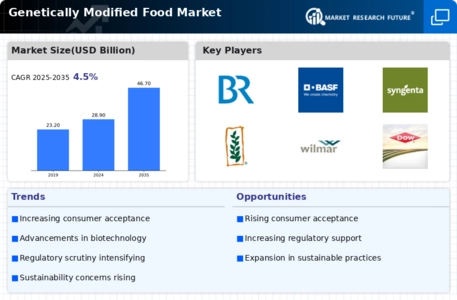The Genetically Modified Food Market is currently characterized by a dynamic competitive landscape, driven by innovation, regulatory developments, and shifting consumer preferences. Major players such as Bayer (DE), Corteva Agriscience (US), and Syngenta (CH) are strategically positioned to leverage advancements in biotechnology and sustainable agricultural practices. Bayer (DE) has focused on enhancing its research and development capabilities, particularly in crop protection and seed technology, which appears to be a response to increasing demand for sustainable farming solutions. Meanwhile, Corteva Agriscience (US) emphasizes digital agriculture and precision farming, aiming to integrate technology into traditional farming practices, thereby enhancing productivity and sustainability. Syngenta (CH) has also been active in expanding its portfolio through strategic partnerships, which collectively shape a competitive environment that prioritizes innovation and sustainability.
In terms of business tactics, companies are increasingly localizing manufacturing and optimizing supply chains to enhance efficiency and responsiveness to market demands. The market structure is moderately fragmented, with a few dominant players exerting considerable influence. This fragmentation allows for niche players to emerge, yet the collective strategies of key players like Bayer, Corteva, and Syngenta create a competitive dynamic that is both collaborative and competitive, as they seek to address global food security challenges.
In August 2025, Bayer (DE) announced a significant investment in a new biotechnology research facility in Germany, aimed at accelerating the development of genetically modified crops that are resistant to climate change. This strategic move underscores Bayer's commitment to innovation and positions the company to lead in the development of sustainable agricultural solutions. The establishment of this facility is likely to enhance Bayer's competitive edge by enabling faster product development cycles and more effective responses to emerging agricultural challenges.
In September 2025, Corteva Agriscience (US) launched a new digital platform designed to provide farmers with real-time data analytics to optimize crop management. This initiative reflects Corteva's focus on integrating technology into agriculture, potentially transforming how farmers make decisions regarding crop inputs and management practices. By leveraging data analytics, Corteva aims to enhance productivity and sustainability, which could significantly influence market dynamics as farmers increasingly adopt technology-driven solutions.
In July 2025, Syngenta (CH) entered into a strategic partnership with a leading agtech startup to co-develop innovative solutions for pest management. This collaboration highlights Syngenta's strategy to enhance its product offerings through external innovation. By partnering with agile startups, Syngenta may accelerate the development of novel pest control solutions, thereby reinforcing its market position and addressing the growing demand for environmentally friendly agricultural practices.
As of October 2025, current competitive trends in the Genetically Modified Food Market are increasingly defined by digitalization, sustainability, and the integration of artificial intelligence. Strategic alliances are becoming more prevalent, as companies recognize the value of collaboration in driving innovation. The competitive landscape is shifting from traditional price-based competition to a focus on technological advancement, supply chain reliability, and sustainable practices. This evolution suggests that future differentiation will hinge on the ability to innovate and adapt to changing consumer expectations and regulatory environments.

















Leave a Comment